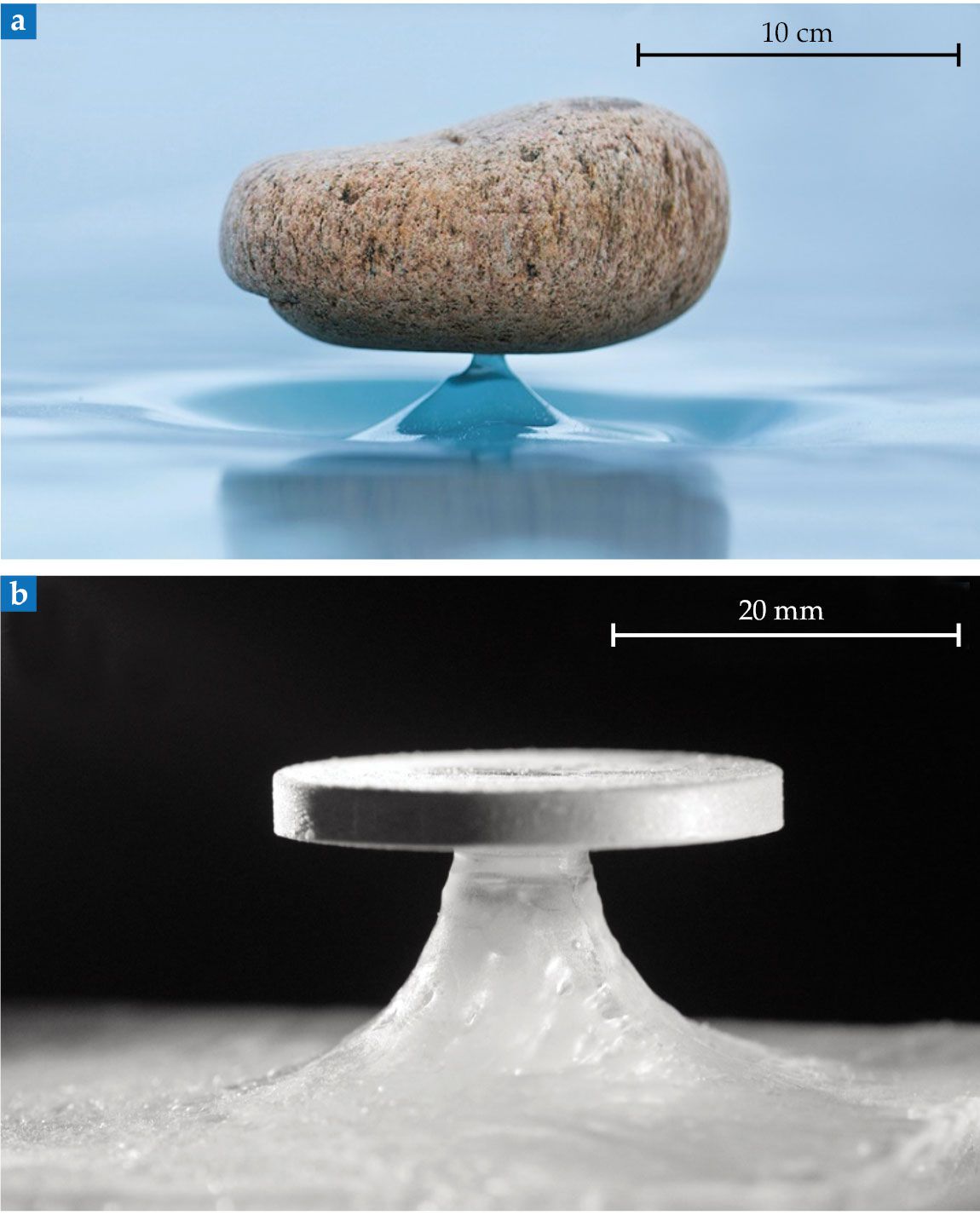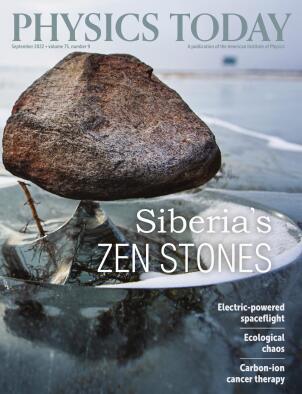The mysterious balancing stones on frozen lakes
DOI: 10.1063/PT.3.5088
Among those who live in a cold enough climate, who has never thrown a large pebble onto the pristine surface of a frozen lake in the hope of breaking the ice? In the Siberian winter on Lake Baikal, any attempt is bound to fail, as the ice typically reaches up to 3 meters thick—enough to support the weight of an 18-wheeler.
But initial disappointment can turn to amazement: After a few weeks sitting on the surface, the stone ends up balancing on a thin pedestal of ice, while the surface around it gradually vanishes into thin air. The phenomenon is manifest in the formation of Zen stones, shown in the

Zen stones in nature and the lab. (a) On Lake Baikal a stone rests on a narrow ice pedestal. (b) In a laboratory, this 30 mm aluminum disk rests on a flat ice surface after sitting in a lyophilizer for 40 hours. (Adapted from Proc. Natl. Acad. Sci. USA 118, e2109107118, 2021, doi:10.1073/pnas.2109107118

Sightings are rare, possibly because specific meteorological conditions are required. Not only must the temperature remain below freezing but the ice surface must remain free of snow for several consecutive weeks. The climate at Lake Baikal meets both conditions: The air temperature is below freezing for an average of five months per year, and precipitation is rare in winter. Thus, the melting of ice is virtually impossible, and the region’s exceptionally low humidity mainly causes the ice to sublimate.
I was struck at how little explanation exists in the literature and set out to reproduce the effect in the lab.
The umbrella effect
In the case of water, the direct phase transition between the solid state and a gas occurs at negative temperatures (in Celsius) and in a very dry atmosphere. What’s more, it’s a slow, endothermic surface process, which therefore requires a constant flux of external energy. Sunlight does the job in nature, either directly in clear weather or diffusely in overcast conditions. Sublimation causes the ice to vaporize at a rate set by the temperature, humidity, and amount of sunlight it receives. From the average winter solar irradiance at the lake and water’s latent heat of sublimation, I estimate the sublimation rate of an ice surface at about 2 mm per day.
A pebble placed on the ice blocks that light, however, and its shade hinders the sublimation beneath it. The rate, nearly zero underneath, gradually increases with distance from the center. The stone therefore acts as an umbrella, which protects the ice from solar irradiance. Known as differential ablation, the process forces the pebble to remain at a constant altitude on an increasingly taller and narrower foot of ice until it eventually falls off. Its lifetime atop the pedestal is roughly the half width of the stone divided by the ablation rate—about 40 days for the stone in panel a of the
Sublimation is not the only possible factor at play. The melting temperature of water decreases with applied pressure. And between 100 MPa and 1 GPa, ice can start melting at temperatures as low as −10 °C. The pressures that Zen stones exert on the ice remain far below that range, however, and any melting would only cause the pebble to sink into the ice. Moreover, ice is known to slowly deform over time—a phenomenon known as plastic creep—which explains why glaciers can flow down mountains. But that too only causes the stone to sink.
As another possible factor, small wind-driven ice particles could potentially create mechanical wear. But the smooth surface of the ice pedestals shows no evidence of erosion. And the typical time required for that ablation process is far longer than the lifetime of a natural Zen stone.
Stones in the lab
To convince my University of Lyon colleague, Nicolas Plihon, and myself of the simple sublimation hypothesis, we reproduced the phenomenon in a laboratory-scale experimental setup. We placed an aluminum disk—a proxy for the stone—on the surface of a block of ice within a commercial lyophilizer, a device whose temperature, pressure, and humidity favor sublimation. The external energy used to sublimate the ice came not from sunlight but from IR radiation of the walls of the vacuum chamber, which remained at room temperature.
In the absence of a stone, the ablation is nearly isotropic and mimics the relative isotropy of natural diffuse sunlight in overcast weather. And its considerably greater sublimation rate of typically 8–10 mm per day allowed us to accelerate the physical mechanism. Indeed, obtaining Zen stones from actual pebbles and disks was straightforward.
The
Dip around the pedestal
One interesting difference exists between natural and laboratory-made Zen stones. In nature a dip always surrounds the ice foot. But that feature was never encountered in our lab experiments. Whereas the umbrella effect is clearly responsible for the pedestal’s formation, a detailed energy balance of the system reveals second-order phenomena. Like any other material, ice and stone emit blackbody IR radiation in a range whose intensities depend on the temperature and the material’s emissivity.
In nature, because of sunlight or ambient wind, the ice and stone are unlikely to remain at the same temperature throughout the day. And that, in turn, causes an imbalance between them. More specifically, if the stone is a few degrees warmer than the ice, the IR it radiates into the ice (in addition to that from sunlight) can exceed that emitted by the ice itself. The effect becomes important in the later stages of Zen-stone formation—when a stone sits on a tall and thin pedestal—as thermal contact is reduced.
Two competing effects are therefore at play: the umbrella effect, which protects the ice, and the excess energy from the stone, which instead accelerates the sublimation and carves out a cavity in the stone’s vicinity. While the former is responsible for the formation of the ice pedestal in the early life of a Zen stone, the latter is responsible for the dip forming around the ice foot in the later stages.
The excess energy is absent in our experiment because of three factors: The lyophilizer was operated in a high vacuum, metal was used for Zen stones, and such stones were smaller, all of which favor a good thermal equilibrium between the disk and the ice.
Glacier tables
In addition to Zen stones, other intriguing formations consisting of a rock resting on a thin pedestal can be found in nature. In a hoodoo, for instance, a hard stone protects a tall column of fragile sandstone from rain and frost-driven erosion. And in a so-called glacier table, a large rock on a low-altitude glacier ends up on a tall foot of ice. The latter case is akin to the Zen stones of Lake Baikal because it involves differential ablation of an ice surface. But the glacier tables’ rock formation, shape, and dynamics are broadly different.
Glacier tables appear on temperate glaciers where the ice (remaining at 0 °C) simply melts because of the warm ambient conditions. Depending on its size and shape, a rock atop the ice can provide enough thermal insulation to either hinder the ice from melting (a process that leads to the formation of the ice pedestal) or increase the ice’s melting rate (a process that leads to the rock sinking into the ice). A recent study has shown that the differential melting of ice for glacier tables is predominantly caused by heat exchange with the surrounding air.
The umbrella effect, which controls the formation of Zen stones, is therefore only a secondary factor for glacier tables. Conversely, although a material’s thermal properties, such as conductivity and specific heat, are crucial for glacier tables, they are insignificant to the formation of Zen stones. Any opaque object left on a sublimating ice surface is likely to wind up atop a narrow foot. Indeed, far from the romantic image sometimes conjured by a Zen stone, the frozen bodies of deceased penguins in Antarctica can occasionally be found perched on top of narrow ice pedestals.
References
► N. Mangold, “Ice sublimation as a geomorphic process: A planetary perspective,” Geomorphology 126, 1 (2011). https://doi.org/10.1016/j.geomorph.2010.11.009
► N. Taberlet, N. Plihon, “Sublimation-driven morphogenesis of Zen stones on ice surfaces,” Proc. Natl. Acad. Sci. USA 118, e2109107118 (2021). https://doi.org/10.1073/pnas.2109107118
► M. Hénot, N. Plihon, N. Taberlet, “Onset of glacier tables,” Phys. Rev. Lett. 127, 108501 (2021). https://doi.org/10.1103/PhysRevLett.127.108501
More about the Authors
Nicolas Taberlet is an associate professor at the University of Lyon in France. His research specialties are the physics of granular materials and pattern formation in ice structures.

